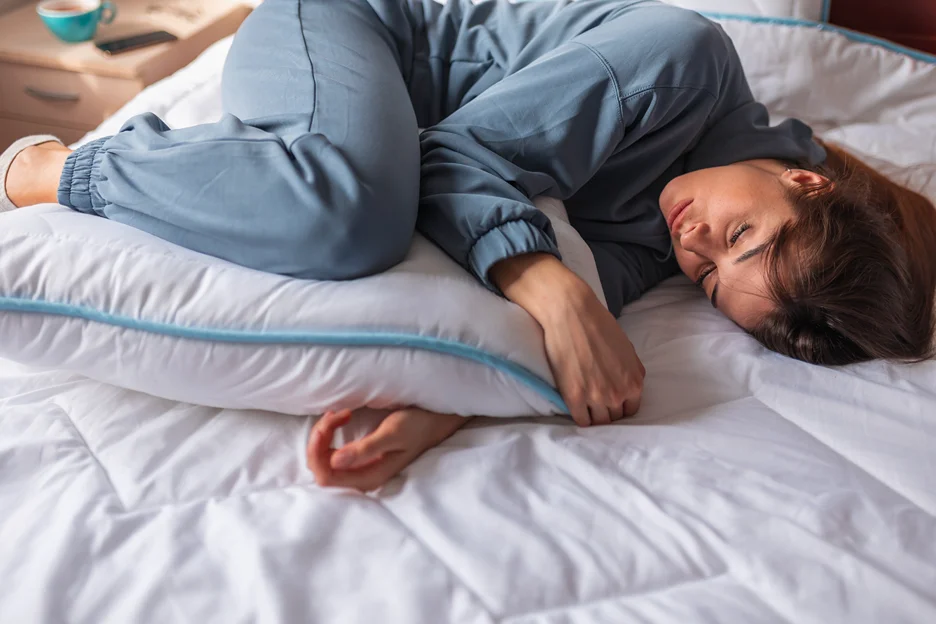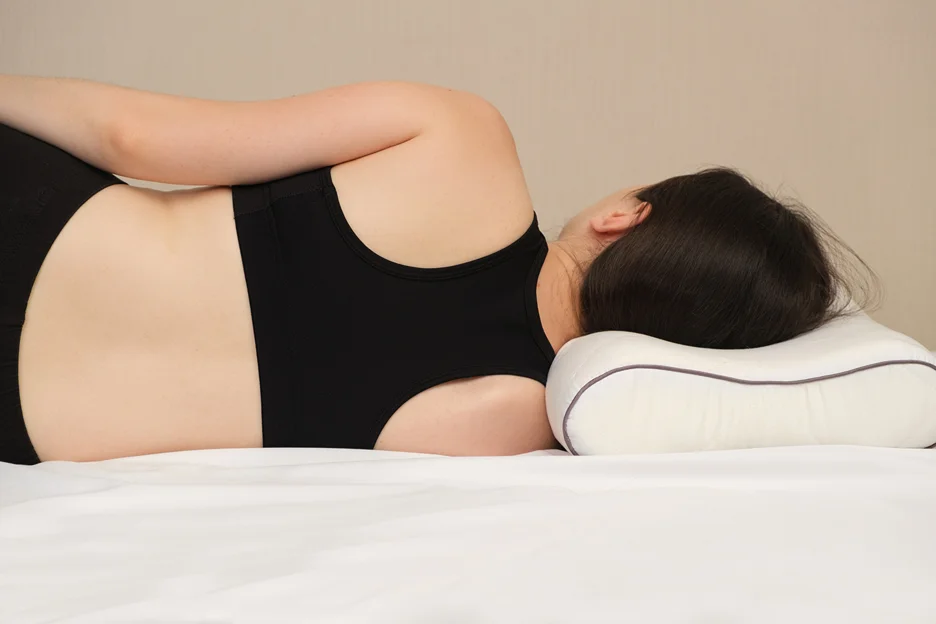Has your lower back been aching at bedtime, making it tough to wind down after a long day? Getting sharp twinges during the night that wake you up frustrated and exhausted?
It’s time to stop back pain from cramping up your sleep style. Learn how to outsmart discomfort for the shut-eye you need with this guide.
We’ll deep dive into techniques, products, and lifestyle tweaks proven to help you get the restorative rest you deserve – aching back and all.
Why Does My Back Hurt So Much At Bedtime?
Before exploring solutions, it helps to understand what’s behind your back pain flare-ups at night. Here are the most common culprits:
Muscle Strains and Spasms
Supporting the upper body all day strains muscles and ligaments in the back. As you unwind in the evening, aches and pains come to the surface. Muscle spasms can also crop up, causing sudden sharp pains.
Weak Muscles
Weak core abdominal and back muscles fail to adequately support your spine. This instability leads to pain.
Stress and Anxiety
Mental anxiety and being stressed out prompts muscle tension that can intensify back pain at night.
Poor Sleep Habits
Insufficient sleep or low sleep quality inhibits your body from recovering from daily strains.
Poor Spinal Alignment
Your spine naturally has curves and arches. But poor posture and old injuries can throw these out of whack. Laying down then puts extra pressure on already misaligned vertebrae and discs. This spells pain.
Mattress and Pillow Problems
An old, sagging mattress that fails to support your body’s natural curves is a recipe for spinal strain and pain. The wrong pillow height leaves your neck at an awkward angle – leading to cascading back pain.
Conditions Like Arthritis, Herniated Discs, Sciatica
Underlying inflammatory conditions, injuries, and pinched nerves put extra pressure on your back. Nighttime is especially problematic since you can no longer “distract” yourself from the discomfort.
Now that you know why your back aches at night, let’s go over solutions to help you sleep soundly. We’ll start with optimizing your sleep posture and position.
How Should I Position Myself in Bed for Lower Back Pain Relief?

Choosing the right sleep position takes the pressure off sore spots and helps you wake up rested (not in more pain). Here are the best positions for back relief and alignment:
Try the Fetal Position
Curling up on your side with your knees bent is an excellent option. Just make sure to place a pillow between your legs. This takes stress off your hips and keeps your spine in a neutral position. Avoid this position if you have sciatica.
Sleep on Your Side with Knees Bent
For side sleeping, bending your knees slightly is ideal. Having legs stacked places strain on the hips and lower back. A small gap between your knees keeps everything aligned.
Alter Side Sleeping Positions
Flipping from one side to the other throughout the night shares the pressure across your body for relief. If one side causes more pain, start with the less painful position.
Consider Stomach Sleeping Carefully
Sleeping on your stomach can pull the natural arch from your lower back, causing aches. But for some, it remains the most comfortable position. Reduce strain with a thin or no pillow to keep your neck neutral.
Using a thin or no pillow for the head and placing a pillow under the pelvis can help reduce strain in this position.
Add Lumbar Support
Placing a pillow behind you if sleeping on your back or under your hips and lower abdomen if on your side provides needed lumbar support. This helps maintain the back’s natural curves. Effectiveness varies per individual, though.
What’s important is finding positions that maintain the spine’s natural alignment while taking pressure off your sore spots to reduce nighttime discomfort. Let’s look at how mattress and pillow setups also factor in.
Choose the Best Mattress for Lower Back Pain Relief
An old, lumpy mattress that fails to properly support your body is asking for a restless, painful night.
By contrast, the right mattress keeps your spine in proper alignment to minimize aches. Here are the best options:
Opt for the Ideal Firmness for You
Mattresses that are too hard or too soft throw the spine out of whack. Look for firm mattresses that cradle pressure points but keep everything aligned. There is no universal best firmness for everyone so some testing will be needed.
Consider Adjustable Air Beds
For tailored support, air beds with different firmness zones take pressure off where you need it most. This customization makes finding the perfect sleep position easier.
Add a Mattress Topper
If buying a new mattress isn’t feasible, a plush mattress topper adds surface-level softness and support to your existing bed. Look for 2-3 inches of conforming memory foam.
Know When It’s Time for a New Mattress
If your mattress is, let’s say, over 7 years old, sags visibly, or fails to support you, it may be time to upgrade. This prevents worsening back issues over time.
For your better reference, here’s a table outlining the pros and cons of various types of mattresses based on firmness:
| Mattress Type | Pros | Cons |
| Soft | Provides pressure relief, especially for side sleepers and lightweight individuals.Conforms to the body’s natural curves, offering a comfortable, plush feel.Can help align hips and relieve joint and muscle pains. | May not provide enough support for back and stomach sleepers.Can cause improper spinal alignment for some sleepers.May wear out faster than firmer mattresses. |
| Firm | Provides better spinal alignment and support, especially for back and stomach sleepers.More durable and less likely to sag over time.Can help alleviate back pain by maintaining proper posture during sleep. | May not provide enough pressure relief for side sleepers and lightweight individuals.Can feel too hard for some sleepers, causing discomfort. |
| Hard | Offers maximum support for the spine, preventing misalignment.Ideal for heavier individuals who require more support.Can help alleviate back pain by evenly distributing body weight. | May be too firm for side sleepers and lightweight individuals, causing discomfort.Can exacerbate pain for those with specific back problems like arthritis and scoliosis. |
Tweak Your Pillow Setup to Calm Back Pain

Your head, neck, and spine should remain aligned on a single plane as you sleep. The right pillow setup makes that happen.
Follow these tips for pillows that ease (not aggravate) your back:
Use 1-2 Pillows Maximum
Stacking too many pillows lifts your head too far and strains your neck and upper back. One or two is plenty – experiment to find what’s comfortable.
Choose Medium Density and Height
Pillows that are too lofty or too flat lead to poor neck alignment. Look for a medium-density pillow around 3-5 inches thick to support neutral spine positioning.
Consider a Knee Pillow
Placing a pillow between your knees when side sleeping keeps your hips aligned and prevents lower back rotation and twisting.
Use a Body Pillow
A body pillow’s long design supports proper spinal alignment and enables comfortable side sleeping by filling gaps between limbs; its soft padding cushions pressure points and enhances circulation to aid healing.
Invest in Quality Materials
Pillows that retain their shape and bounce back during the night provide consistent support. Look for memory foam, latex, feather, or hybrid pillows.
Here’s a table comparing pillow firmness with regard to back pain:
| Pillow Firmness | Perks | Downsides |
| Soft | Provides gentle support and conforms to the shape of the head and neck.Ideal for stomach sleepers who need a thin, plump pillow under their face.Can be moldable and suitable for various sleeping positions. | May not provide enough support for back and side sleepers.Can cause improper spinal alignment for some sleepers.May lose shape faster than firmer pillows and get lumpy over time. |
| Firm | Provides better spinal alignment and support, especially for back and stomach sleepers.More durable and less likely to sag over time.Can help relieve back pain by maintaining proper posture during sleep. | May not provide enough pressure relief for side sleepers and lightweight individuals.Can feel too hard for some sleepers, causing discomfort. |
| Hard | Offers maximum support for the spine, preventing misalignment.Ideal for heavier individuals who require more support.Can help alleviate back pain by evenly distributing body weight. | May be too firm for side sleepers and lightweight individuals, causing discomfort.Can worsen pain for those with specific back problems like arthritis and scoliosis. |
With the right sleep setup, you can wake up ready to face the day pain-free. Now let’s go over supportive nighttime habits.
Optimize Your Nightly Routine for Better Sleep With Back Pain
Your pre-bedtime habits and bedroom environment greatly impact sleep quality and spinal comfort. Here are smart tweaks for your p.m. routine:
Stick to Consistent Sleep Hours
Going to bed and waking up at the same time keeps your circadian rhythm regulated for deeper, easier sleep. Aim for 7-9 hours nightly.
Avoid Pre-Bed Screen Time
Smartphone and laptop use before bed hampers melatonin release and keeps your mind wired and anxious. Power down devices 1-2 hours before bedtime.
Do Light Stretches and Yoga Poses
Try Alternating Hot and Cold Therapy
Applying heating pads or ice packs before bed soothes inflammation and loosens tight muscles. Contrast them for all-over relief.
Diffuse Soothing Essential Oils
Lavender, bergamot, and clary sage essential oils promote relaxation when diffused before bedtime. This calms your mind and body for sleep.
Building these supportive habits into your nighttime routine leads to higher quality, restorative sleep so you wake with less back pain.
Manage and Prevent Back Pain During the Day
How you care for your back during your waking hours directly correlates to the amount of nighttime discomfort you’ll experience.
Follow these tips to keep the pain from bothering you when it’s time for bed:
Focus on Core-Strengthening Exercises
Building strength in your core abdominal and back muscles better supports your spine’s natural alignment for 24/7 relief. Try bridges, planks, and leg raises. Be sure to them properly to avoid injury.
Address Any Muscle Imbalances
If certain muscles are weaker or tighter than others, it can lead to poor spinal alignment and pain. Target stretches and exercises that address muscle imbalances can improve back comfort in various sleep positions.
A skilled physiotherapist should assess and correct underlying imbalances.
Improve Your Posture
Slumping puts strain on your back’s ligaments and muscles leading to imbalances, pain, and poor sleep posture. Maintain an upright posture as often as possible.
Lose Extra Weight
Excess weight places heavy pressure on your spine, especially when lying down. Losing extra pounds reduces this burden for more restful sleep.
Eat an Anti-Inflammatory Diet
Foods like leafy greens, salmon, and extra virgin olive oil reduce systemic inflammation – including in back muscles and joints – for less pain.
A holistic approach that cares for your back around the clock is important for resolving nighttime discomfort. With time and consistency in implementing these tips, you’ll be sleeping soundly and waking refreshed.
Ready to Finally Sleep Without Back Pain? Try Kaly for 24/7 Support

If you’re still suffering from persistent back pain that disrupts your nights – or want extra guidance optimizing your sleep – connect with an experienced doctor through Kaly.
They can provide customized treatment, lifestyle, and sleep recommendations so you can have healthy, supported rest free of aches and pains.
Schedule a free intro call today to get matched with a compassionate provider ready to help you resolve your back issues for blissful, restorative sleep all night long – completely free from any discomfort.
